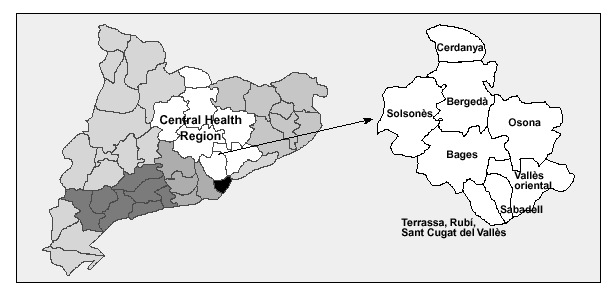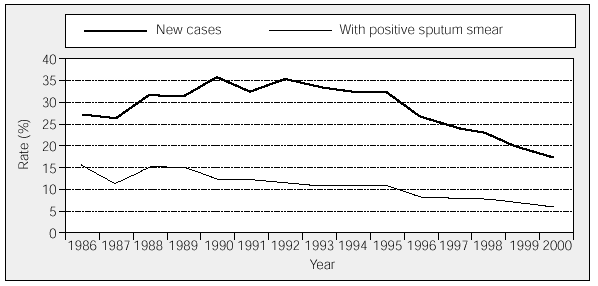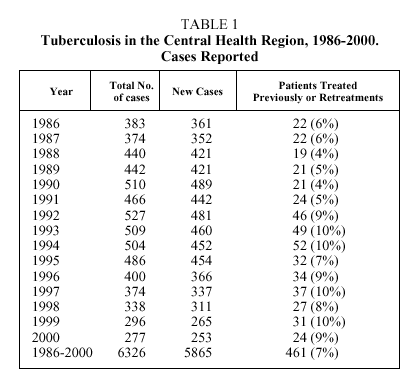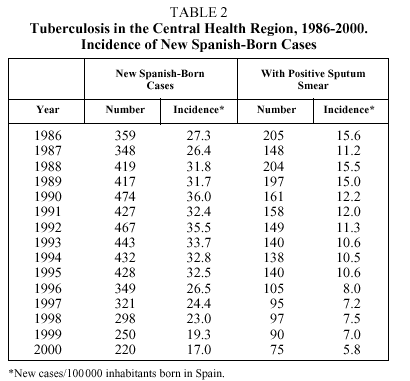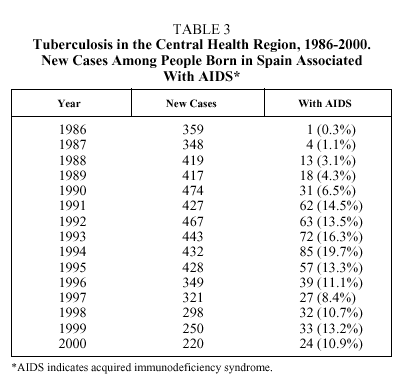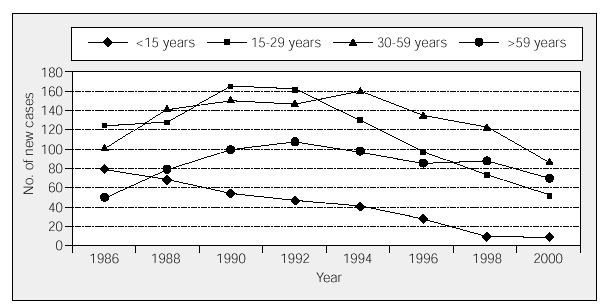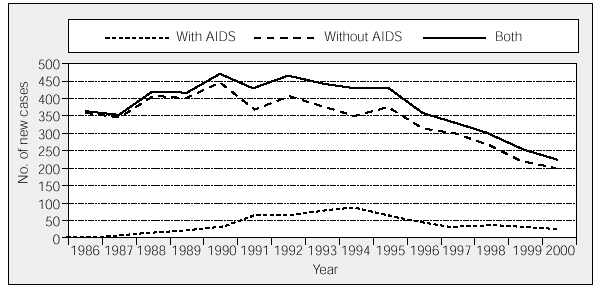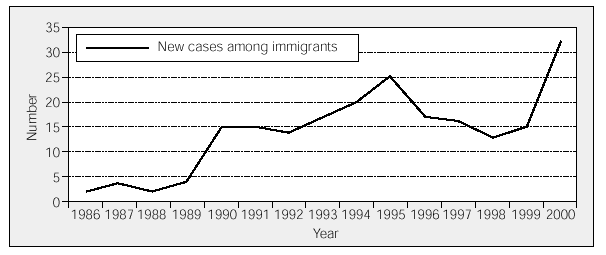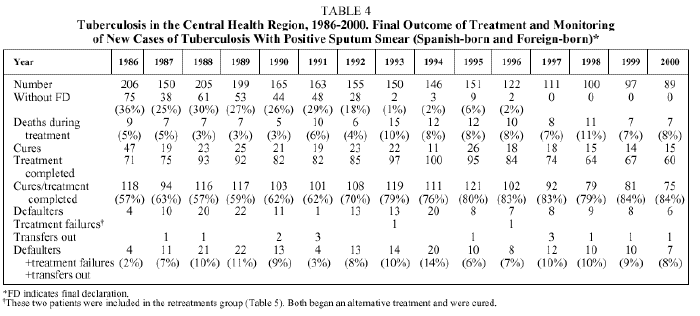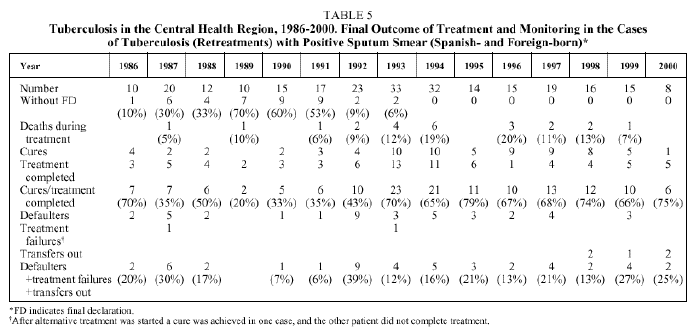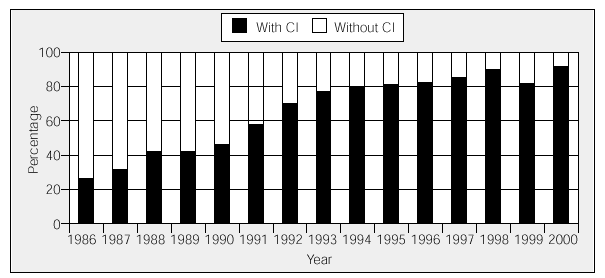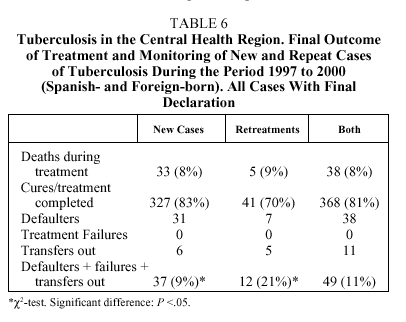Introduction
The Central Health Region (CHR) of Catalonia (Figure 1) designed a tuberculosis control program (the CHR Tuberculosis Program) in 1985. In addition to its mandatory objectives--to obtain real knowledge about the current situation and trend of the tuberculosis endemic, and to put into place the measures necessary for its control--the program was also designed to monitor the final outcome of these measures and assess the results.1 Until 1985, tuberculosis surveillance in the CHR basically consisted in obtaining notification of the cases diagnosed rather than assessing the results achieved by the control measures in place. The essential components of a tuberculosis control program are the diagnosis of cases of active tuberculosis, the correct treatment of these patients, and the identification and treatment of infected persons at risk of developing the disease.2
Figure 1. Central Health Region of Catalonia.
The initial results of the program were reported 5 years after its implementation at the World Conference of the American Thoracic Society and the International Union against Tuberculosis and Lung Disease, held in Boston in 1990.3 Seven years later came a second study which, in addition to reporting results, also evaluated the cooperation between the program's staff and the health care personnel of the CHR.4
The aim of the present study was to assess the degree of tuberculosis control achieved during the first 15 years the CHR Tuberculosis program was in effect (1986-2000) and to report on the results.
Materials and Methods
The CHR of Catalonia (Figure 1), with 1 317 059 inhabitants, comprises an area of 6577 km². The population has increased by 7% since 1991. Since the birth rate and death rate have remained stable, this increase must be attributed to migration. Migration into the area is mainly internal, coming from other parts of Spain, although recently the number of immigrants from other countries has been increasing. Some 75% of the population is concentrated in 30% of the area of the CHR, where the predominant activity is industrial and the largest cities (Sabadell and Terrassa) are located. In the rest of the region, agricultural activities are important in addition to industry, and Manresa, Granollers, Vic and Berga are the most important towns.5 The CHR's public health network comprises 73 primary care clinics, 13 general hospitals (7 referral) with 3036 hospital beds, and 17 long-term care facilities with 757 beds.5
The CHR Tuberculosis Program was designed in 1985 by a team of specialists from the Hospital de Enfermedades del Tórax in Terrassa,1 and was implemented in 1986. It has a central office, and the operating model is based on the active participation of the CHR's public and private health care services.
Health service personnel notify the central office of all diagnosed cases of tuberculosis by submitting a form called the "Extended Declaration of Tuberculosis Disease." This document is composed of three auto-calculating sheets, the first of which is used to record the following information: name of notifying doctor and clinic, and the patient's name, personal details, place of birth, and social situation. In addition, this sheet details the clinical and radiologic characteristics of the disease, findings of microbiology and pathology, risk factors for the development of tuberculosis, history of chemoprophylaxis or antituberculosis treatment, and current medication and treatment. The second sheet, or Final Declaration (FD), includes the following information: side effects; results of bacteriology during and on completion of treatment; and whether or not the patient completed treatment, died, or was transferred out. The first sheet is sent to the central office when the patient is diagnosed, and the second (the FD) when he or she completes treatment, abandons treatment, dies or is transferred to another center or facility. The central office takes the necessary steps to obtain information about the final outcome of patients who transfer out. The third sheet, which contains all of the above information, is retained by the notifying doctor.
The contact investigation (CI) is conducted by the doctor or clinic where the patient was diagnosed or by the corresponding primary care team. The investigation is carried out according to an established protocol, which stipulates the following steps: contacts must be identified and their personal details recorded, a tuberculin test is performed in all cases unless there is a clear history of positive results, and a clinical and radiological evaluation may be undertaken. The results are sent to the central office in a document designed for this purpose, which details the contacts identified, registered and studied, the results of the tuberculin test and of the radiologic investigation (if one is carried out), the diagnosis, and the treatment plan adopted.1
The program's central office publishes an annual report which summarizes the number and characteristics of the cases notified during the calendar year covered by the report by way of the first sheet of the Extended Declaration. This report also includes the follow-up data reported on the second sheet or FD relating to the cohort of patients from the preceding year. This procedure was recommended after the implementation of the program.6 The central office also collaborates with the CHR health service in the diagnosis and treatment of infected persons and patients who have developed active tuberculosis. Furthermore, the central office is responsible for carrying out CIs when these involve collective environments, such as workplaces, educational institutions, etc.1
Figure 2. Tuberculosis in the Central Health Region. Incidence rate of new cases among people born in Spain, 1986-2000.
At the outset, protocols were drawn up for the diagnosis and treatment of tuberculosis infection and disease, which include criteria that define completion of treatment in both cases.7 These protocols are based on national and international guidelines9-16 and were subsequently updated, extensively so in a recent publication.8
In order to assess the degree of tuberculosis control in the CHR, on the basis of the program's registers, two parameters were studied: the evolution of the epidemiological profile of tuberculosis between 1986 and 2000 and the results of the mandatory measures undertaken to control the disease (treatment and CIs) during this period.
The study of the epidemiological profile was based on the number of cases notified involving people resident in the CHR (both new cases and retreatments) and on the annual evolution of this figure. New cases resident in the CHR were classified according to their place of birth: Spain or elsewhere. The following parameters were studied with respect to new cases involving persons born in Spain: the evolution of the annual incidence (total number of new cases and new cases with positive sputum smear for Mycobacterium tuberculosis in their diagnosis); and distribution by age groups (<15 years old, 15-29, 30-59, and >59). These age groups were chosen with a view to monitoring the evolution of tuberculosis in children (<15 years old) and in adolescents and young adults (15-29 years old), since this population represents a sentinel marker for the evolution of risk of infection in a community, an important parameter in the assessment of the trend in tuberculosis cases.17 The incidence was calculated using the census figures for the resident population of the CHR, excluding the foreign-born population.18 Given the importance of infection with human immunodeficiency virus (HIV) as a risk factor for the development of tuberculosis,19 the trend of the frequency of association between acquired immunodeficiency syndrome (AIDS) and tuberculosis was also studied. In the population of foreign-born cases, we studied the annual evolution of the number of cases by birthplace.
The results of the mandatory tuberculosis control measures were studied in all cases with positive sputum smear at the time of diagnosis (new cases and retreatments, whether or not the patients were born in Spain). The time elapsed between the onset of symptoms and the start of treatment was also studied as part of the evaluation of the mandatory control measures. (This parameter was studied in the cases reported in 1986, 1990, 1995, and 2000, with the calculation in weeks of the mean, median, and mode.) Particular attention was paid to the analysis of the final outcome of the treatment and follow up of patients, and whether or not a CI was carried out.
On the basis of the data provided by the FD and following current guidelines,20 the patients of each annual cohort, and separately new cases and retreatments, were classified using the following definitions: died (if death occurred during the course of treatment, and irrespective of its cause), transfers out (individuals who transferred out of the jurisdiction of the CHR and were lost to follow up), treatment failures (persistence of positive sputum smear 5 months after the start of treatment or later, or a positive result occurring after a negative result), defaulters (noncompliant patients whose treatment was interrupted for 2 consecutive months or longer), cures (patients who completed treatment and had a negative sputum smear at the end of treatment and on at least one prior occasion), treatment completed (patients who completed treatment but who do not meet the criteria to be classified as either cures or treatment failures; this group included patients who had completed treatment but had only a final negative sputum smear, or only a negative smear in some preceding month, or else who had no bacteriological result on record), cures/treatment completed (the sum of the patients corresponding to the two preceding classifications).
All the patients classified as cures/treatment completed had completed the treatment, a necessary condition for accepting that the patient was cured, since the efficacy of antituberculosis treatment is based on controlled treatment trials that have demonstrated the treatment regimen that must be followed.10-14
Tuberculosis control is considered effective if the sum of the patients who do not adhere to treatment (defaulters), plus the treatment failures, plus the transfers out remains below 10% of the cohort of patients studied.6
With respect to the CI, we analyzed the annual proportion of cases in which a CI was carried out among persons living with the patient, as well as frequent family, workplace, and leisure contacts. The outcome of all the CI's undertaken was also studied.
Results
Epidemiological Evolution of Tuberculosis in the Central Health Region of Catalonia
Between 1986 and 2000, a total of 6326 cases was reported (new cases: 5865; retreatments: 461) (Table 1). The number of new Spanish-born cases was 5652 (96%) and that of new foreign-born cases was 213 (4%). Table 2 and Figure 2 show the annual evolution of the incidence of new Spanish-born cases, and Figure 3 shows that of their distribution by age groups. Table 3 and Figure 4 show the evolution of the association of AIDS and tuberculosis. New cases decreased from 474 in 1990 to 220 in 2000 (a 54% decrease), with a continuous decline in new cases in both the <15 years old age group and the 15-29 year old group (Figure 3). The association of tuberculosis cases and AIDS peaked in 1994 (19.7%) and then declined to 10.9% in 2000 (Table 3). Figure 5 shows the annual evolution of the number of new foreign-born cases (the highest number recorded was in 2000). The place of origin of these patients was distributed as follows: North Africa and the Sahara, 134 (63%); sub-Saharan Africa, 34 (16%); Latin America, 18 (8%); Asia, 12 (6%); Eastern Europe, 4 (2%); European Union, 11 (5%). In all, 95% of these cases came from countries with a high prevalence of tuberculosis.21
Figure 3. Tuberculosis in the Central Health Region. Evolution of the number of new cases among people born in Spain by age groups, 1986-2000.
Figure 4. Tuberculosis in the Central Health Region. New cases among people born in Spain, with and without acquired immuno deficiency syndrome (AIDS), 1986-2000.
Figure 5. Tuberculosis in the Central Health Region. New cases among people not born in Spain, 1986-2000.
Results of the Mandatory Tuberculosis Control Measures
The following are the means (SD), medians (range) and modes of the times that elapsed between onset of symptoms and diagnosis. In 1986, the mean was 7.7 (6.4) weeks (2-28 weeks); the median was 4, and the mode, 4. In 1990, the mean was 6.6(6.8) weeks (2-28 weeks); the median, 4, and the mode, 4. In 1995, the mean was 7.1(6.1) weeks (2-32 weeks); the median, 4, and the mode, 2. In 2000, the mean was 7.0(6.5) weeks (2-32 weeks); the median, 4, and the mode, 2.
On the basis of the data recorded in their FDs, the patients of each annual cohort were classified using the definitions stipulated by the guidelines mentioned above.20 Tables 4 and 5 show that the number of patients without an FD declined every year, particularly after 1993. After 1997, an FD was available for all new cases, and since 1994 for all retreatments. Table 6 shows the final outcome for all cases (new and retreatments) recorded from 1997 to 2000, all of whom had an FD. This tables shows that the sum of the defaulters, plus the treatment failures, plus the patients who transferred out represents 11% (9% of new cases and 21% of retreatments).
A CI was carried out in 26% of the cases reported in 1986, in 45% of those reported in 1990, and in 80% in 1994. This percentage remained above the 80% level from 1995 until 2000, by which time it had reached 92% (Figure 6). Since 1986, 6191 contacts have been investigated, giving rise to the detection of 2875 infected individuals (46%) and 157 persons with active disease (3%). Chemoprophylaxis was indicated in 2079 patients.
Figure 6. Tuberculosis in the Central Health Region. Percentage of smear-positive patients (new cases and retreatments, Spanish-born and foreign-born), with and without contact investigation (CI).
Discussion
It is necessary to identify the trend of endemic tuberculosis in order to assess how well it is being controlled.21,22 Hence, new cases must be separated from cases that have been treated previously21-23 because it is the annual evolution of the appearance of new cases (incidence) that reflects the trend of endemic tuberculosis, as stressed by Styblo.22 The evolution of the percentage of retreatments also reflects the situation of tuberculosis control. This percentage should not exceed 10% to 20%.14 In the CHR, retreatments represent 7% (Table 1), and this figure is similar to that reported for Catalonia as a whole (6.3%).24
New cases were analyzed separately depending on whether the patients were Spanish-born or foreign-born, since 95% of the latter come from countries with a high prevalence of tuberculosis, and it is, therefore, highly probable that they were infected before coming to Spain. Mycobacterial genome studies have shown that in most patients originating from countries with a high prevalence of tuberculosis, the illness is due to the reactivation of tuberculosis infection acquired in the patient's place of origin.25,26 Moreover, according to various studies carried out in countries where the number of immigrant patients with tuberculosis is higher than in the CHR, transmission of the disease to the native population has not been demonstrated, has been sporadic, or has occurred only in small numbers.21,25,26
In developed countries with a long history of high levels of immigration, a decline has been observed in the incidence of new cases of tuberculosis in the native population despite the existence of a rise in the number of immigrants with the disease.21,27 It appears that endemic tuberculosis affecting native populations and that affecting immigrant populations evolve separately, with only sporadic reciprocal influence. The incidence and morbidity of tuberculosis should, therefore, be studied separately in each population, making it possible to obtain more information about the impact of a foreseeable increase in immigration in our environment. The number of new foreign-born cases in the CHR could not be evaluated quantitatively until 2000 (Figure 5). In 2001 and 2002, 34 and 48 cases were reported respectively according to the tuberculosis program records.
The highest number of new cases of tuberculosis involving persons born in Spain was recorded in 1990, 4 years after the start of the program. This pattern is attributable to the progressive increase in the number of notifications rather than to any annual increase in tuberculosis morbidity. This is confirmed by the paradox that the highest number of smear-positive patients corresponds to the first 4 years of the program when the reported tuberculosis morbidity was lower than during the 1990-1995 period, when the number of smear-positive patients declined (Table 2). It is a known phenomenon that the number of notifications increases after the first few years of the implementation of any program.17
In the CHR, the decline in new Spanish-born cases since 1990 has been 54%, similar to the decline observed in cases among individuals born in the United States of America (55% during the same period).27 The decline in tuberculosis morbidity in our region, and the consequent decrease in the risk of infection have favored a continuous decline in the incidence of the disease among children (<15 years of age) and adolescents and young adults (15-29 years of age) (Figure 3). In 1998, patients belonging to the 30 to 59 and >59 years age groups predominated, reflecting the decline in the risk of infection among the younger cohorts.17
This decline in tuberculosis morbidity has not been affected by the appearance of the infection as a result of HIV. In 1986, only one case of tuberculosis with HIV infection was reported in the CHR, and this figure increased to 31 in 1990, the year with the highest tuberculosis morbidity. The number of cases of tuberculosis associated with HIV infection reached 85 in 1994, representing an increase of 174% with respect to 1990, but in this year tuberculosis morbidity had already declined by 9% with respect to 1990 (Table 3). Since 1994, the total annual number of new cases of tuberculosis has declined in parallel with the number of new cases of tuberculosis associated with HIV infection (Figure 4), which fell from 85 in 1994 to 24 in 2000 (Table 3).
In developed countries like Spain, tuberculosis is self-limiting because each smear-positive patient (the ones who maintain the endemic) does not usually give rise to the 20 infected individuals necessary to generate another smear-positive patient in order to maintain the endemic at the same level.17 (Of 20 infected individuals active disease will develop in only 10%, that is, 2 individuals, and only half of these, or 1 individual, will have a positive sputum smear.) If, in addition, an effective treatment, such as that currently available, significantly shortens the period during which the patient is contagious, it is easy to see that antituberculosis treatment is the most productive way of accelerating the decline of endemic tuberculosis, especially if started promptly.2,28
In the CHR, the mean time that elapsed between onset of symptoms and start of treatment in smear-positive patients was 7.7 weeks in 1986, and it was lower subsequently (6.6 in 1990, 7.1 in 1995 and 7.0 in 2000). The fact that the mode has gone from four to two weeks since then25 reflects this decrease.
According to Styblo and Salomao,29 in order to achieve effective tuberculosis control, the percentage of smear-positive patients who complete treatment must remain ≥80%, which, if we assume an estimated mortality of 4% to 5%, represents a percentage of defaulters of between 10% and 15%. One of the objectives defined by the World Health Organization is a cure rate of 85%, a percentage which, taking into account a probably inevitable minimum of 5% of deaths (due to tuberculosis and other causes), leaves 10% of the patients, a group fundamentally composed of defaulters, transfers out, and treatment failures.6,20
In our program, the final outcome for each patient is reported in the FD, a form completed by the doctor who has followed up on the patient, and who, in most cases, is the same physician who diagnosed and reported the case. This is the most desirable model, and the one recommended in the guidelines.6 Table 4 shows that, between 1986 and 1992, the percentage of new cases in which no FD was available went from 36% to 18%, and the percentage of cured patients who had completed treatment went from 57% to 70%. During the period 1993 to 1996, when the number of patients without an FD declined considerably, the percentage of cured patients who had completed treatment was between 76% and 80%; and when there were no longer any patients without an FD (1997-2000), this percentage continued to increase, ranging between 79% and 84%. This evidences, as is logical, that in order to avoid a false assessment of tuberculosis control in a cohort of patients, the final outcome should be known for all of them.
Although FD's have been available for all retreatments since 1994, in order to evaluate all smear-positive patients (both new cases and retreatments), and to assess the degree of tuberculosis control, the study paid particular attention to the period from 1997 to 2000, during which an FD was available for every patient. During this period, and referring to all cases (new cases and retreatments), 81% of patients were classified as cure/treatment completed, 83% of new cases and 70% of retreatments (Table 4). In a study carried out in 6 autonomous communities in Spain (Asturias, Catalonia, Galicia, La Rioja, Murcia, and the Basque country) during the period from 1996 through 1997, 69.7% of patients completed treatment, but the final outcome was not known in 11.5%.30 According to the published literature,6 the percentages of patients who adhered to treatment in various European Union countries were as follows: Italy, 83% (1995-1996); Holland, 82% (1995); Germany, 68% (1994-1995); and France, 66% (Paris, 1992).
If a patient does not complete treatment, not only is the cure not admitted, in addition, this failure may have unfavorable repercussions on tuberculosis control.10-14 Recent guidelines recommend that in order to improve the degree of control of endemic tuberculosis, it is more effective to work on the percentage of noncompliant patients rather than on that of compliant patients, since noncompliant patients will come to represent a source of infection alongside those that appear among new cases. Tuberculosis control is considered to be effective when the number of defaulters, plus the number of treatment failures and transfers out remains below 10% of the patient cohort being evaluated.6 In the CHR during the period 1997-2000, this combined group represented 9% of new cases, 21% of retreatments, and 11% of all cases (new cases and retreatments) (Table 6). During the same period, the proportion of defaulters was also high among alcoholic patients and immigrants.31
While the treatment of patients is fundamental for tuberculosis control, the investigation of the contacts of contagious patients is also important, since this facilitates the active detection of persons with tuberculosis as well as recently infected individuals at high risk for developing the disease.2,28,32 Although not all infected individuals discovered during the course of these investigations are necessarily recently infected, this activity is the only way of detecting them.
Treatment of latent tuberculosis infection (TLTI), or secondary chemoprophylaxis, contributes to the control of tuberculosis because it prevents future cases.33 However, not all infected individuals are going to progress to disease, since the risk of developing active tuberculosis depends on certain conditions.16 Obviously, TLTI will prevent a greater number of eventual tuberculosis cases among infected people at high risk of developing the disease, such as recently infected individuals, than among low-risk individuals, although the number of disease cases prevented will also depend on the efficacy of the TLTI and the patients' adherence to the treatment regimen.33 Thus, in order to obtain the maximum benefit for tuberculosis control from the CI, or, in other words, in order to prevent the largest possible number of patients from developing active disease, the investigation program should envisage treatment of the infected individuals detected with the most ive TLTI regimen, ensuring total or maximum adherence.16,33
In the early years of the program, CIs were carried out in only a small percentage of cases. However, by 1994, this figure had increased to 80%, subsequently remaining above this level and reaching 92% in 2000 (Figure 6), thereby achieving and surpassing the objective established in the CHR plan for the period 1999-2001 (a CI in 85% of diseased patients with positive sputum smears).34 In Catalonia as a whole, this percentage was 87% in 2001.35 The investigation of 6191 contacts between 1986 and 2000 produced the expected percentage32 of infected and ill individuals, and this figure is similar to the corresponding figure for Catalonia as a whole.35
During the initial phase of the program, particular attention was paid to the final outcome of treatment in smear-positive patients, and less to obtaining information concerning the adherence to TLTI of infected individuals detected during the course of a CI. However, since 2001, once the process for obtaining information about the final outcome of the treatment of diseased patients had been consolidated,8 the program has emphasized the need to obtain an FD of completion of TLTI, which is also an important datum for the assessment of the degree of tuberculosis control attained. Nonetheless, information is available for the period 1986 through 2000 from certain centers in the CHR, which reported adherence percentages of >80% for the regimen of 9 months with isoniazide,36,37 the most effective TLTI.16
Our conclusion is that during the 15 years the CHR Tuberculosis Program has been in place, a notable degree of tuberculosis control has been achieved. This is demonstrated by the declining trend of tuberculosis morbidity, similar to that in other developed countries27; by the decline in tuberculosis morbidity in sentinel age groups (<15 and 15-29 years old); and by the fact that in the last 4 years the sum of defaulters, treatment failures and transfers out represented 11% of the total of all new cases and retreatments with positive sputum smear (Table 6), a figure only slightly higher than the 10% considered desirable.6 Further evidence of effective control is seen in the high percentage (92%) of CIs carried out.
Acknowledgments
We would like to make special mention of the dedication of the current staff of the Central Office of the Central Health Region's Tuberculosis Program: Emma Bosch (secretary), María Ángeles Castilla (DUE), Francisca García and Celestina Lucía (clinical aides). We would also like to express our gratitude to all the people who have worked in this Office between 1986 and 2000. We thank Anna Busqué, of the Regió Sanitària Centre, Servei Català de la Salut (CatSalut), for statistical information concerning the population; M.ª Luisa de la Puente, head of the Unitat de Planificació de la Regió Sanitària Centre, CatSalut; Fernando Marín, head of the Subdivisió d´Atenció Primària Àmbit Centre, CatSalut; and Ramon Canal, director of the Regió Sanitària Centre, CatSalut, for his encouragement and institutional support, and finally all the people who have held these positions between 1986 and 2000.
Finally, our special thanks to all the personnel working in hospitals and primary health care in the Central Health Region who, with the reports on their work, diagnosis and treatment of the patients, and contact investigations, have provided the Central Office of the Program with the raw data needed to make possible this assessment of the considerable degree of tuberculosis control attained.
Correspondence: Dr. J.M. Pina Gutiérrez.
Avda. Jacquard, 87-89, 3.º, 2.ª. 08222 Terrassa. Barcelona. España.
E-mail: 4940jpg@comb.es
Manuscript received December 5, 2002.
Accepted for publication March 25, 2003.


